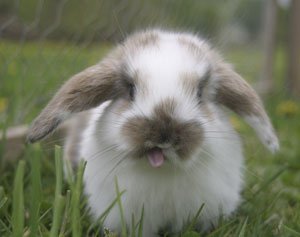
Size: The size and space need to keep rabbits depends on the breed. Smaller breeds can weigh in the neighborhood of 2 to 3 pounds. The Flemish Giant is regarded as the largest breed in the world and may grow 3 ft. in length and weigh up to 24 pounds.
Compatibility: Does (females) can often live amongst each other peacefully. Bucks (males) will fight if housed together. Rabbits can sometimes be kept successfully with Guinea pigs, but should be kept away from cats, dogs, and other small animals.
Appeal: Rabbits make popular pets for a number of reasons. They are friendly and social and will live happily indoors, in apartments or in an outdoor hutch. If properly trained, they will hop along on a lead (slowly) and can learn to use a little box. They need less exercise, can be left alone during the day (with proper housing) and they won't disturb the neighbors.
Drawbacks: To keep a rabbit indoors, the house must be sufficiently rabbit-proofed. Electrical cords, carpet, and wooden furniture are all in danger of being chewed. Fireplaces, tall furniture and certain houseplants can all pose serious dangers. Rabbits shed. A rabbit's coat, nails, and ears all need regular grooming and attention and they need a supply of fresh foods to stay healthy.
Diet: Rabbits need a diverse diet that includes commercially prepared pellets, hay, root vegetables, greens, and some fruit.
Problems & Health Issues: Rabbits are susceptible to various digestive problems. They are also vulnerable to serious viruses like myxomatosis and VHD. They need to have their teeth checked regularly, and if spending time outside need to be vaccinated for fleas and other pests and from diseases spread by wild rabbits.
Lifespan: A rabbit's longevity depends a lot on genetics and the care it receives. Typically, a rabbit can expect to have a lifespan that averages 6-7 years, sometimes longer.
Interesting Facts: Rabbits use their whiskers like antennae, especially at night. The whiskers feel and remember the tunnels and walls of a familiar burrow and that information is stored in the rabbits memory. A rabbit put in an unfamiliar burrow will instantly panic because it doesn't "feel" right. Most rabbits will run for cover when being pursued rather than escaping down an unfamiliar burrow.

About The Author: Ellen Brown is an environmental writer and photographer and the owner of Sustainable Media, an environmental media company that specializes in helping businesses and organizations promote eco-friendly products and services. Contact her on the web at http://www.sustainable-media.com
Add your voice! Click below to comment. ThriftyFun is powered by your wisdom!